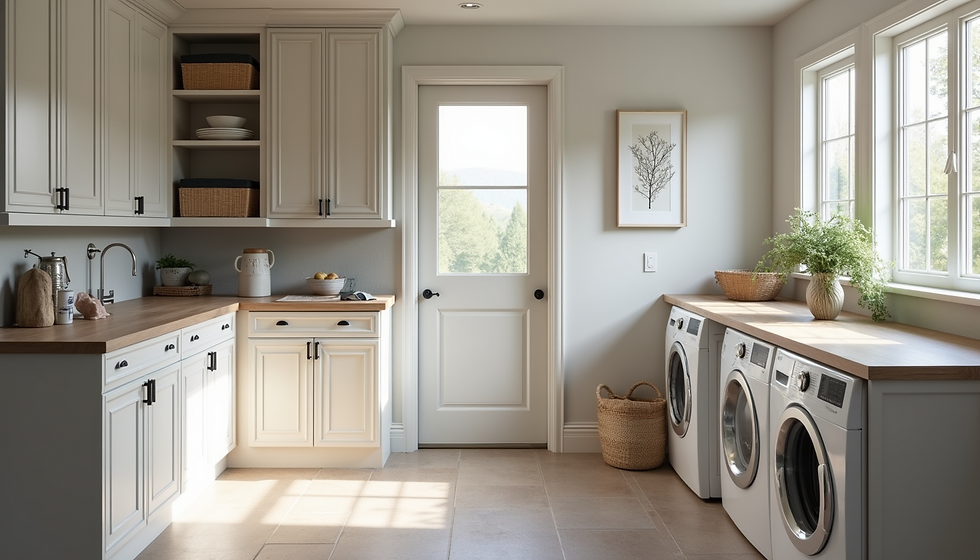Transforming Your Home: Practical Tips for Tackling Small Space Remodeling Challenges
- The Home Tuner
- Jun 11
- 3 min read
Updated: Jul 25
Remodeling can be a thrilling adventure for any homeowner, but it also comes with its set of challenges—especially when it comes to small spaces. In this blog post, we’ll explore effective solutions to common remodeling dilemmas that homeowners face. Whether you're dealing with an awkward layout or striving to maximize space, we've got you covered. Let’s dive in!
Understanding the Challenges of Small Space Remodeling
Small space remodels often present unique challenges that can be frustrating for homeowners. Limited square footage means every inch counts, and making the wrong design decision can lead to a cramped or inefficient living space. From poor flow to limited storage, understanding these challenges is the first step to successfully transforming your home.
Maximizing Space: Clever Storage Solutions
One of the most significant concerns with small space remodeling is finding enough storage. A cluttered home can quickly feel overwhelming, but there are several strategies to maximize space.
Invest in Multi-Functional Furniture
Choosing furniture that serves multiple purposes can dramatically improve your space's efficiency. Consider a sofa bed for the living room, a coffee table with storage, or ottomans that double as seating. This approach not only keeps your space organized but adds a stylish touch to your interiors.
Utilize Vertical Space
Don’t forget to look up! Vertical storage solutions can be a game-changer. Install shelves or wall-mounted cabinets that draw the eye upward, making the space feel larger. Hanging pot racks in the kitchen or tall bookshelves in the living room can help keep your floors clear and organized.
Dealing with Awkward Layouts
Many small homes come with unconventional layouts that can make remodeling a challenge. Instead of letting these quirks deter you, embrace them with innovative design.
Create Defined Zones
Open floor plans can lead to confusion about how to use a space effectively. Defining zones helps give each area a purpose. Use furniture arrangements, rugs, or even different wall colors to create distinct areas for dining, lounging, or working.
Consider Flow and Accessibility
In any small space, it's essential to maintain a good flow throughout the areas. Rearranging furniture to improve the pathway can make a world of difference. Think about how you move through your home and adjust your layout to facilitate smooth transitions.
Lighting: The Unsung Hero of Small Spaces
Lighting can significantly influence how a small space feels. By utilizing various lighting techniques, you can create a sense of openness and warmth.
Layer Your Lighting
Avoid relying solely on overhead fixtures. Incorporate ambient, task, and accent lighting to add depth to your space. Table lamps, floor lamps, and wall sconces can create a warm and inviting atmosphere while illuminating darker corners.
Choose Light Colors and Reflective Surfaces
A little paint can go a long way in a small space. Lighter colors tend to reflect light, helping your room feel larger and airier. Additionally, incorporating mirrors can create the illusion of depth, making cramped quarters seem more sprawling and inviting.
Personalizing Your Small Space
One of the most exciting parts of remodeling is the chance to express your personality. But how can you make a small space your own without overwhelming it?
Be Selective with Décor
When working with limited space, it’s crucial to choose your decorative items wisely. Opt for fewer, larger pieces instead of many smaller trinkets. This strategy helps avoid clutter while making a bold statement in your space.
Incorporate Your Style
Whatever your style—be it bohemian, modern, or rustic—find ways to incorporate it into your small space. Use textiles, artwork, or themed décor that resonates with you and instantly gives your home a personal touch.
Common Mistakes to Avoid
While tackling a small space remodel, homeowners often fall into specific traps that can lead to frustration. Here are a few common mistakes to be mindful of:
Overcrowding the Space
One of the biggest pitfalls is filling your small area with oversized furniture or too many decorative elements. Stick to a few key pieces that are proportionate to your space to ensure your home feels balanced and inviting.
Ignoring Functionality
In the quest for aesthetics, don’t forget about functionality. Ensure each piece of furniture you choose serves a purpose. If it doesn’t contribute to the utility or beauty of the space, it may be best to leave it out.
Conclusion
Remodeling small spaces can be daunting, but it doesn’t have to be. By understanding common challenges and implementing clever solutions, you can transform your home into a stylish, functional, and personalized space.
Whether you're maximizing your storage with multi-functional furniture or embracing the quirks of your layout, trust that effective planning and creativity can yield the beautiful and efficient home you desire.
Happy remodeling!





Comments